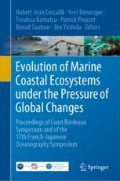Abstract
The Japan Sea includes its own deep-water formation mechanics and a thermohaline circulation system similar to those of the Mediterranean Sea. Long-term trends of warming and decreasing oxygen concentration owing to global warming have been reported in the deep water of the Japan Sea. Although the minimum oxygen decrease rate of about 1000 m suggests a relatively active supply of new deep water to the depths, the overall deep-water formation has been stagnant since the 1970s throughout the water column. In addition to the gradual linear trends, interdecadal variation occurs in the temperature and oxygen concentration of the abyssal Japan Sea. The correlation between the interdecadal variation and the Arctic oscillation index indicates that the deep-water formation in the Japan Sea is modulated by Arctic oscillation via sea surface temperature in the East China Sea. This is an example of a teleconnection system on the marginal seas scale. For these reasons, we propose a collective name for this system: the Pacific Asian marginal seas system.
Access this chapter
Tax calculation will be finalised at checkout
Purchases are for personal use only
References
Bindoff NL, Willebrand J, Artale V, Cazenave A, Gregory J, Gulev S, Hanawa K, Le Quéré C, Levitus S, Nojiri Y, Shum CK, Talley LD, Unnikrishnan A (2007) Observations: oceanic climate change and sea level. In: Climate change 2007: the physical science basis. Contribution of working group I to the fourth assessment report of the intergovernmental panel on climate change. Cambridge University Press, Cambridge, pp 385–432
Cui Y, Senjyu T (2010) Interdecadal oscillations in the Japan Sea proper water related to the arctic oscillation. J Oceanogr 66:337–348. https://doi.org/10.1007/s10872-010-0030-z
Cui Y, Senjyu T (2012) Has the upper portion of the Japan Sea proper water formation really been enhancing? J Oceanogr 68:593. https://doi.org/10.1007/s10872-012-0115-y
Gamo T (1999) Global warming may have slowed down the deep conveyor belt of a marginal sea of the northwestern Pacific: Japan Sea. Geophys Res Lett 26:3137–3140
Gamo T, Nozaki Y, Sakai H, Nakai T, Tsubota H (1986) Spatial and temporal variations of water characteristics in the Japan Sea bottom water. J Mar Res 44:781–793
Gamo T, Momoshima N, Tolmachyov S (2001) Recent upward shift of the deep convection system in the Japan Sea, as inferred from the geochemical tracers tritium, oxygen, and nutrients. Geophys Res Lett 28:4143–4146
Isobe A, Beardsley RC (2007) Atmosphere and marginal-sea interaction leading to an interannual variation in cold-air outbreak activity over the Japan Sea. J Climate 20:5707–5714
Kawamura H, Wu P (1998) Formation mechanism of Japan Sea proper water in the flux center off Vladivostok. J Geophys Res 103:21611–21622
Kim K, Kim KR, Min DH, Vlokov Y, Yoon JH, Takematsu M (2001) Warming and structural changes in the East (Japan) Sea: a clue to future changes in global oceans? Geophys Res Lett 28:3293–3296
MEDOC Group (1970) Observation of formation of deep water in the Mediterranean Sea. Nature 227:1037–1040
Minami H, Kano Y, Ogawa K (1999) Long-term variations of potential temperature and dissolved oxygen of the Japan Sea proper water. J Oceanogr 55:197–205
Senjyu T, Sudo H (1993) Water characteristics and circulation of the upper portion of the Japan Sea proper water. J Mar Syst 4:349–362
Senjyu T, Sudo H (1994) The upper portion of the Japan Sea proper water; its source and circulation as deduced from isopycnal analysis. J Oceanogr 50:663–690
Senjyu T, Aramaki T, Otosaka S, Togawa O, Danchenkov M, Karasev E, Volkov Y (2002) Renewal of the bottom water after the winter 2000–2001 may spin-up the thermohaline circulation in the Japan Sea. Geophys Res Lett 29(7). https://doi.org/10.1029/2001gl014093
Seung YH, Yoon JH (1995) Some features of winter convection in the Japan Sea. J Oceanogr 51:61–73
Sudo H (1986) A note on the Japan Sea proper water. Prog Oceanogr 17:313–336
Thompson DWJ, Wallace JM (1998) The Arctic Oscillation signature in the wintertime geopotential height and temperature fields. Geophys Res Lett 25(9):1297–1300
Uda M (1934) The results of simultaneous oceanographical investigations in the Japan Sea and its adjacent waters in May and June. J Imp Fish Exp Sta 5:57–190
Watanabe YW, Wakita M, Maeda N, Ono T, Gamo T (2003) Synchronous bidecadal periodic changes of oxygen, phosphate and temperature between the Japan Sea deep water and the North Pacific intermediate water. Geophys Res Lett 30:2273. https://doi.org/10.1029/2003GL018338
Worthington LV (1981) The water masses of the world ocean: some results of a fine-scale census. In: Evolution of physical oceanography. MIT Press, Cambridge, pp 42–69
Yasui M, Yasuoka T, Tanioka K, Shiota O (1967) Oceanographic studies of the Japan Sea (1)–water characteristics. Oceanogr Mag 19:177–192
Acknowledgements
The author would like to thank the members of the local organizing committee of the Coast Bordeaux 2017 and the 17th French–Japanese Oceanography Symposium. Part of this study was supported by the Environment Research and Technology Development Fund of Ministry of the Environment, Japan (2-1604) and JSPS KAKENHI Grant Number 18H03741.
Author information
Authors and Affiliations
Corresponding author
Editor information
Editors and Affiliations
Rights and permissions
Copyright information
© 2020 Springer Nature Switzerland AG
About this paper
Cite this paper
Senjyu, T. (2020). The Japan Sea: A Changing Pacific Asian Marginal Sea. In: Ceccaldi, HJ., Hénocque, Y., Komatsu, T., Prouzet, P., Sautour, B., Yoshida, J. (eds) Evolution of Marine Coastal Ecosystems under the Pressure of Global Changes. Springer, Cham. https://doi.org/10.1007/978-3-030-43484-7_3
Download citation
DOI: https://doi.org/10.1007/978-3-030-43484-7_3
Published:
Publisher Name: Springer, Cham
Print ISBN: 978-3-030-43483-0
Online ISBN: 978-3-030-43484-7
eBook Packages: Biomedical and Life SciencesBiomedical and Life Sciences (R0)

